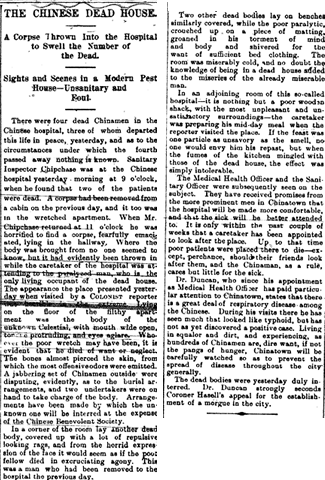The Chinese Hospital
The Chinese hospital was seen as a necessary establishment for the Chinese immigrants in Victoria. Western medicine did not appeal to the Chinese people because they were accustomed to using Chinese herbs, which were not available in the regular hospitals. One of the main goals of the Chinese Consolidated Benevolent Association was to care for the sick and poor, that had no one to turn to in Canada for assistance. These individuals were provided accomodation in a “small wooden hut” that acted as a hospital. It was labelled Taipingfang, meaning “peaceful room.”24 Rather than a hospital used to provide treatments, this little shack was used for the sick and poor to rest, be fed, and stay warm. It also served as a location where the sick and poor could die in peace.
One individual, referred to as the caretaker, did everything in the Taipingfang. The caretaker cleaned, prepared meals and medicine/herbs, and removed the dead bodies. Because only one caretaker could function at a time in this small space, the “hospital” often got run down. One reporter published an article in the Daily Colonist of the horrible conditions.
The Daily
Colonist, March 19, 1893, p. 7.
The awful conditions reported, allowed the Chinese community to realize how desparate a “real” hospital was needed in the Chinese community.
The CCBA raised money through donations and purchased at lot in Chinatown at 555 Herald Street, which attached to the CCBA on Fisgard Street.25 The building was complete in 1899. The method the CCBA used to collect money to keep the hospital running was through a fee for any Chinese people returning to China. Each person leaving for China was required to pay a $2 fee that was used to support the Chinese Hospital. Once the $2 fee was paid the individual was issued a receipt and then could purchase a ticket home. Without the receipt a ticket home was not available for a Chinese individual. The elderly and children were not required to pay the fee.
